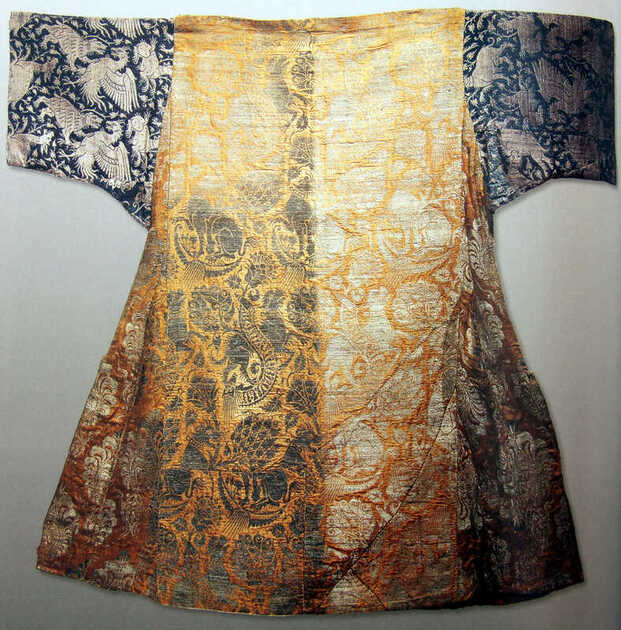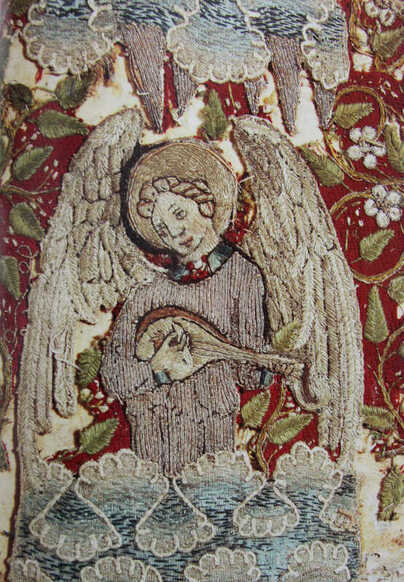|
Last year, I was lucky enough to visit the Abegg Stiftung in Riggisberg, Switzerland when attending the CIETA conference in Zurich. Their permanent textile exhibition is worth a visit anytime. We were also allowed to visit the conservation laboratory. That was a real treat! And I was able to browse their publications. In my opinion, they are the gold standard when it comes to textile publications. But that comes at a cost. And them being in Switzerland doesn't help either. So being able to see before you buy was a real bonus. One of the books I had been ogling for a while was: "Liturgische Gewänder des Mittelalters aus St. Nikolai in Stralsund" (=Medieval liturgical vestments from St. Nikolai in Stralsund) by Juliane von Fircks published in 2008. Let's explore! The website description of the contents of the book does not mention embroidery. It turns out that the majority of the liturgical vestments from Stralsund do not have embroidery (some do, bear with me). Instead, they are made from different combinations of exotic silks. Many are woven with gold threads made of strips of leather. The designs are amazing and very exotic. They were made between 1300 and the second half of the 15th century. Their origins are Central Asia, Persia, Spain, Italy and Northern Germany. The silks made in Central Asia were known as panni tartarici (Tartar cloths) and were very popular in Western Europe. The vestments made with them look a little like a crazy quilt :). Very colourful and luxurious. Not only does the book describe these silks and their history and manufacture in great detail, the cut of the vestments is also extensively studied (with the help of Birgit Krenz). The silks were imported and then tailored locally (Northern Germany). As the Tartar cloths were so expensive, it is fascinating to read how the tailors made the best use of every little scrap. As said, the majority of the vestments from Stralsund are not embroidered. Of the 39 catalogue entries, only three chasubles, one bursa, one substratorium, one wreath and one possible hat brim are embroidered. All date between AD 1400 and AD 1500. One of the chasubles shows the familiar nativity story according to Saint Bridget. Another chasuble shows a floral/foliage design partly made of leather padding on which freshwater pearls were sown. Not a technique we see often. The third chasuble has a beautifully rendered Christ on the cross. The silken embroidery in fine split stitches is stunning. The substratorium shows lettering stitched in cross stitch. Unlike today, the cross stitch was rather rare in the Middle Ages.
But my favourite embroidery is the angel playing the lute on the back of the bursa. The embroidery of the angel and the clouds consists of linen slips appliqued onto red woollen twill. The thick white contour of the clouds indicates that these were once edged with freshwater pearls. Foliage and small white flowers are stitched directly onto the red woollen twill to form the background. The angel wears a tunic stitched in double rows of membrane gold (now dull and silvery in appearance). The rows run vertically and are couched in a simple bricking pattern. By cleverly starting and stopping threads and by adding a few darker lines for the folds, the definition of the different parts of the garment is achieved. As always, this book from the Abegg Stiftung does not disappoint. It has many beautiful pictures and close-ups of the different textiles. The chapters explain how the treasury of St Nicolai survived to the present day. And how difficult it is to identify surviving pieces from church inventories. Each catalogue entry has very elaborate technical details. What threads were used and on what fabric (mostly with thread count). At present, the museum in Stralsund is closed for refurbishment so I do not know if (some of) these pieces are part of the permanent exhibition. Before I became an embroideress, I visited the museum as an archaeologist and analysed some animal bone found in the refectory of the Katharinenkloster. That was some 20 years ago ... Literatur Fircks, J. von, 2008. Liturgische Gewänder des Mittelalters aus St. Nikolai in Stralsund. Abegg-Stiftung, Riggisberg. Grimm, J.M., 2005. Keine Lust zum Geschirrspülen? Auswertung der spätmittelalterlichen Tierknochen und der botanischen Reste aus der Remternische des Katharinenklosters in Stralsund. In I. Ericsson & R. Atzbach eds. Depotfunde aus Gebäude in Zentraleuropa (=Bamberger Kolloquien zur Archäologie des Mittelalters und der Neuzeit 1), Berlin, 173-180.
6 Comments
|
Want to keep up with my embroidery adventures? Sign up for my weekly Newsletter to get notified of new blogs, courses and workshops!
Liked my blog? Please consider making a donation or becoming a Patron so that I can keep up the good work and my blog ad-free!
Categories
All
Archives
July 2024
|
Contact: info(at)jessicagrimm.com
Copyright Dr Jessica M. Grimm - Mandlweg 3, 82488 Ettal, Deutschland - +49(0)8822 2782219 (Monday, Tuesday, Friday & Saturday 9.00-17.00 CET)
Impressum - Legal Notice - Datenschutzerklärung - Privacy Policy - Webshop ABG - Widerrufsrecht - Disclaimer
Copyright Dr Jessica M. Grimm - Mandlweg 3, 82488 Ettal, Deutschland - +49(0)8822 2782219 (Monday, Tuesday, Friday & Saturday 9.00-17.00 CET)
Impressum - Legal Notice - Datenschutzerklärung - Privacy Policy - Webshop ABG - Widerrufsrecht - Disclaimer








 RSS Feed
RSS Feed